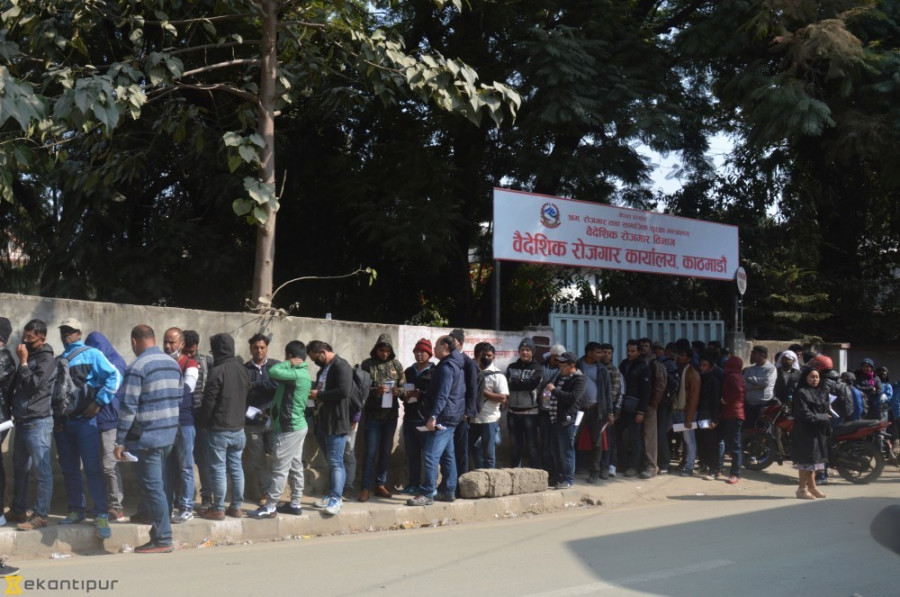National
Local units start gathering data for Prime Minister job programme
Unemployed population has started registering for employment opportunities as part of the Prime Minister Employment Programme that guarantees a minimum 100 days of work to jobless citizens in a year.
Chandan Kumar Mandal
Unemployed population has started registering for employment opportunities as part of the Prime Minister Employment Programme that guarantees a minimum 100 days of work to jobless citizens in a year.
Unemployed citizens of working age between 18 and 59 years can benefit from the scheme that was rolled out in February this year.
Collection of details has begun at the ward level of all 753 local units, according to Prakash Dahal, head of the programme under the Ministry of Labour, Employment and Social Security.
“Registration kicked off on March 15 and will continue till April 13. Unemployed people are submitting their applications at the ward level stating that they do not have jobs and would want to enrol themselves in the scheme,” Dahal told the Post.
In order to get registered, one should fill up an employment form and submit it to his or her concerned ward office. The ward office will forward the details to the Employment Service Centre (ESC) set up in all local units.
Each ESC will have details of jobs available in government projects at the local level and fill the vacancies by hiring the unemployed people.
The registration process, however, has not been effective in all local units due to the vacant posts of employment coordinators.
The Labour Ministry had announced vacancies for 753 employment coordinators. Only 521 officers were selected; among them, many never turned up to sign the contract and some resigned shortly after they were hired.
When the ministry announced vacancies for 275 employment coordinators recently, 9,884 people had filed their applications.
“In places where the designated officials have not reached to collect the data, we have asked the local authorities to accept the applications submitted by unemployed people,” said Dahal.
To cope with the absence of employment coordinators, the labour ministry has also requested the Ministry of Federal Affairs and General Administration to fill the appointments.
With only three months remaining for the current fiscal year to end, the government, which is still collecting data on unemployed population, is unlikely to achieve its target of launching the scheme within this fiscal year.
“We plan to complete the data collection within the month of Chaitra (mid-April). Once the remaining employment coordinators are hired and data collection is completed, the details will be sent to the ESC which will then verify the details of unemployment in the local units,” said Dahal, adding that ensuring 100 days of work as per the scheme would be difficult this fiscal year.
“Providing a minimum 100 days of work within this fiscal may not be feasible with the end of the year fast approaching. Ensuring minimum days of jobs also depends on availability of work. They can only be mobilised if there are vacancies in public projects,” said Dahal.
The scheme has identified a total of 13 sectors—agriculture, cooperatives and animal husbandry; energy, irrigation and river training; drinking water and sanitation; forest and environment; tourism promotion; road transport; education, youth and sports; reconstruction; community infrastructure construction; large and national pride projects; information and communication technology; industry; and health—where unemployed population could be mobilised.
The approved list of unemployed manpower will be updated by employment coordinators on Employment Management Information System, an online application, which will maintain nationwide data on unemployed population as well as available employment opportunities.
The highlight of the scheme is the provision that pledges sustenance allowance if the government cannot guarantee the minimum 100 days of work in a year. Upon failure to guarantee minimum days of employment, the state has to provide sustenance allowance equal to half of the salary fixed for a period of 100 days.
However, not everyone registered under the scheme and not getting the minimum days of employment opportunities will be entitled to the allowance. Only those who come from families with not a single person employed can receive the allowance.
Likewise, only those whose families earn lower than the minimum income ceiling fixed by the government, and have no family member abroad on foreign employment are entitled to the sustenance allowance.
“The unemployment compensation doesn’t look possible this year considering that there’s only three months for the fiscal year to end. The compensation scheme can only work if the government decides to distribute such sustenance to families in the lower income bracket,” Dahal told the Post.




 5.47°C Kathmandu
5.47°C Kathmandu








%20(1).jpg&w=300&height=200)





